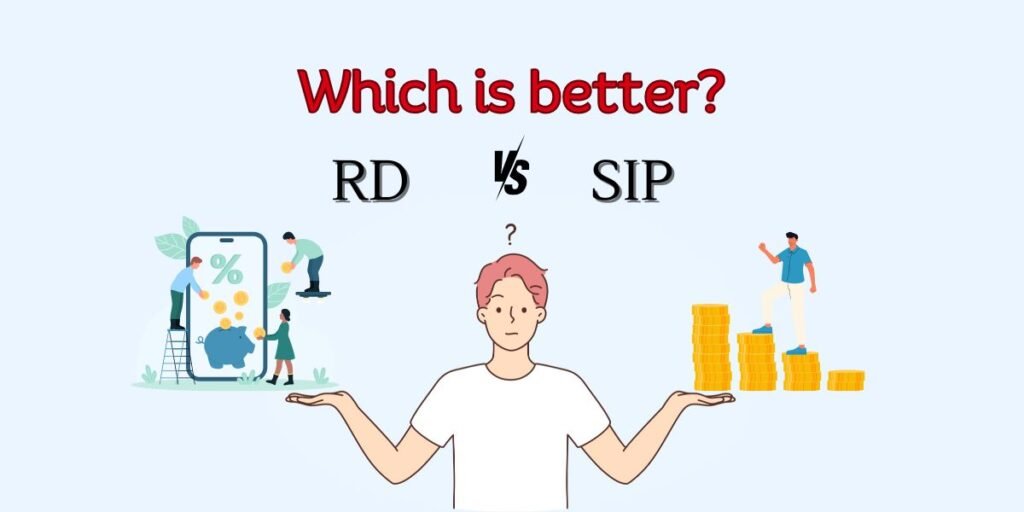The choice between investing in Recurring Deposits (RD) or Systematic Investment Plans (SIP) depends on your financial goals, risk tolerance, and investment preferences. Let’s compare the two:
Risk and Returns:
RDs are low-risk investments offered by banks, and they provide fixed returns. The interest rates are predetermined and do not change during the RD tenure.
SIPs, on the other hand, involve investing in mutual funds, which are subject to market fluctuations. While they carry a higher level of risk compared to RDs, they also have the potential for higher returns over the long term.
Liquidity:
RDs generally have a fixed tenure, and premature withdrawals may result in a penalty or a reduction in interest rates.
SIPs offer better liquidity as you can redeem your mutual fund units at any time, though some funds may have exit loads if you redeem too early.
Flexibility:
RDs have a fixed investment amount at regular intervals, and the interest rate is fixed at the time of investment.
SIPs allow you to invest a variable amount at regular intervals, providing flexibility in adapting to changing financial circumstances.
Tax Implications:
Tax is imposed on the interest earned upon maturity of an RD. No tax is applicable if the interest income from the RD is up to Rs 40,000 (Rs 50,000 for senior citizens). However, if the income exceeds this threshold, a 10% Tax Deducted at Source (TDS) is deducted.
SIPs in Equity Linked Saving Schemes (ELSS) offer potential tax benefits under Section 80C of the Income Tax Act, as they qualify for tax deductions up to a certain limit.
Inflation Hedge:
RD returns may not always beat inflation, potentially eroding the purchasing power of your money over time.
SIPs in equity mutual funds have the potential to outpace inflation, providing better long-term wealth creation.
Diversification:
RDs are a type of fixed-income investment, offering limited diversification.
SIPs allow you to invest in a diversified portfolio of stocks, bonds, or other securities, spreading risk across different asset classes.
Investing money is a crucial financial decision that requires careful consideration of various options. Two popular choices for individuals seeking to grow their wealth are Recurring Deposits (RD) and Systematic Investment Plans (SIP).
In this article, we will delve into the advantages and disadvantages of both RD and SIP to help you make an informed decision about where to invest your hard-earned money.
Recurring Deposits (RD)
RD typically stands for “Recurring Deposit.” A Recurring Deposit is a financial investment option offered by banks and financial institutions. In an RD, an individual agrees to deposit a fixed amount of money at regular intervals (usually monthly) into their RD account for a predetermined period.
When initiating a Recurring Deposit (RD) with a bank, you have the flexibility to choose the investment period ranging from 1, 2, 3, 4, 5, to 10 years. The interest rates vary across banks based on the chosen tenure.
However, if you opt for a post office RD, you are required to commit to a minimum investment period of 5 years, as post office RDs are specifically designed for this duration.
Advantages of Recurring Deposits
Fixed Returns: RDs offer a fixed interest rate throughout the investment tenure, providing a predictable return on investment.
Low Risk: RDs are considered low-risk investments as the interest rate is predetermined, offering stability compared to market-linked investments.
Disciplined Saving: RDs require individuals to deposit a fixed amount regularly, promoting disciplined saving habits.
No Market Dependency: RDs are not influenced by market fluctuations, making them a suitable option for risk-averse investors.
Disadvantages of Recurring Deposits
Lower Returns: While RDs are low risk, they typically offer lower returns compared to market-linked investments like SIPs.
Lack of Flexibility: Once the RD is initiated, the deposit amount and tenure are usually fixed, offering limited flexibility for adjustments.
Tax Implications: The interest earned on RDs is taxable, and for those in higher tax brackets, it may impact overall returns.
Systematic Investment Plans (SIP)
SIP commonly stands for “Systematic Investment Plan.” It is an investment strategy in which an individual invests a fixed amount of money at regular intervals, typically monthly, in a mutual fund or other financial instruments.
SIPs are designed to make investing more accessible and convenient for individuals by allowing them to invest smaller amounts regularly, promoting financial discipline.
Advantages of Systematic Investment Plans
Market-Linked Returns: SIPs provide the opportunity to invest in the equity market, offering the potential for higher returns over the long term.
Rupee Cost Averaging: SIPs follow the rupee-cost averaging method, helping investors buy more units when prices are low and fewer units when prices are high, reducing the impact of market volatility.
Flexibility: Investors can start, stop, increase, or decrease SIP investments at their convenience, providing flexibility in managing finances.
Potential for Wealth Creation: SIPs, with their exposure to the equity market, have the potential to create substantial wealth over the long term.
Disadvantages of Systematic Investment Plans
Market Risks: SIPs are subject to market risks, and the value of investments can fluctuate based on market conditions.
Lack of Fixed Returns: Unlike RDs, SIPs do not offer fixed returns, and the final value depends on market performance.
Discipline Required: While RDs enforce discipline through fixed deposits, SIPs rely on investors maintaining consistency in contributions to maximize benefits.
In summary, if you prefer capital preservation and a fixed return with lower risk, RDs may be suitable. However, if you are willing to take on some risk for the potential of higher returns and want more flexibility, liquidity, and the benefits of diversification, SIPs could be a better choice.
It’s important to align your investment choice with your financial goals and risk tolerance, and you may also consider consulting a financial advisor for personalized advice.
